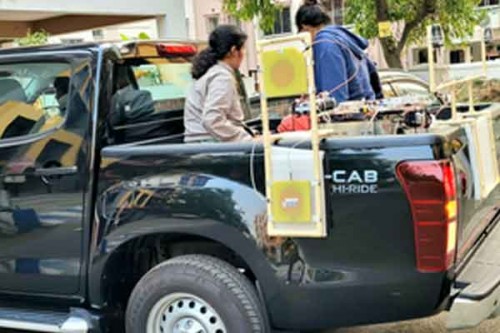SAR on car for surveillance! Ex-ISRO official promoted Sisir Radar innovates

Chennai, Feb 9 (IANS) A synthetic aperture radar (SAR) on a car for surveillance? Yes, that is what space sector startup, Sisir Radar Private Ltd has innovated.
Normally, the SAR is fitted to a satellite to look down through the clouds.
After testing its SAR on a drone, Sisir Radar has now successfully tried that principle with a radar fitted on a car and picked up signatures at 1.5 km distance.
“Conventional surveillance radars are big in size and can be a target of attack. On the other hand, a mobile SAR radar cannot be an easy target,” Tapan Misra, Founding Director and Chief Scientist, told IANS.
He was earlier a Director at the Space Applications Centre of Indian Space Research Organisation (ISRO). He was the brains behind the Indian space agency’s RISAT series of SAR satellites as well as the Dual Frequency SAR on the Chandrayaan 2 orbiter.
Misra said with a coarse angular resolution radar and small antenna, the car moved and picked up signals.
Using signal processing the acquired signals were converted to high angular resolution SAR image at ground gazing view, Misra added.
“The SAR on the car was able to penetrate the foliage and picked up signatures at a distance of 1.5 km. The vehicle was moving at varying speed and need not be moving at a constant speed or be stationary,” Misra said.
He said the SAR picked up signatures of metallic objects, fences, buildings and others.
The motion compensation was a nightmare when viewed from conventional SAR processing. The speed of the CAR-SAR during the data capture varied from 0 kmph to 50 kmph including a few stops. The innovation needed to implement the motion compensation was immense.
Synthetic Aperture Radar or SAR is a special kind of imaging radar technology that can provide extremely accurate high resolution imagery of the terrain through clouds, smoke and dust even in pitch dark conditions. SAR imagery provides much higher resolution than other forms of remote sensing technology such as hyperspectral and multispectral. SAR is a critical technology for strategic reconnaissance and planning as well as for disaster management.
Recently Sisir Radar hit success at the prestigious iDEX DefSpace Challenge with its projects for development of “L/P band Continuous Wave SAR (synthetic aperture radar) payload for LEO Small Satellites” and “Unfurlable, Electronically Steering Antenna for L/P band SAR payload” for Indian Air Force (IAF).
“A grant of Rs 3 crore is also there for development of the products,” Misra told IANS.
He said L and P band SAR have an advantage over other frequencies (like X band) when it comes to penetration capabilities through rain, clouds, foliage and vegetation in a tropical country like India, and underground penetration capabilities in dry terrain.
According to Misra, the L band SAR will provide 1 metre resolution, spotlight resolution in Stripmap mode. The current industry standard is 5-10 metre in L band.
Misra said both the L and P band will operate simultaneously from a satellite borne SAR. Recently, Sisir Radar successfully developed and tested the world’s highest resolution L-Band SAR fitted on a drone. With 0.2 metre resolution, this is by far the highest L band SAR in the world, he said.
While Sisir Radar will develop the SAR, the IAF will select the satellite partner, which will also be another startup. The SAR and other payloads will be fitted to the satellite and then flown up, Misra said.

|

|

